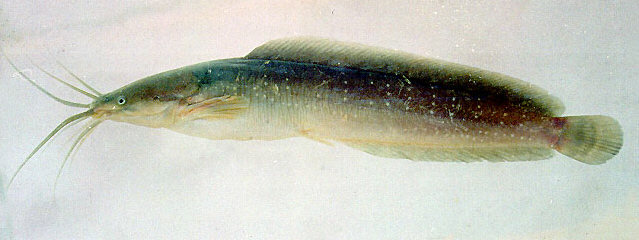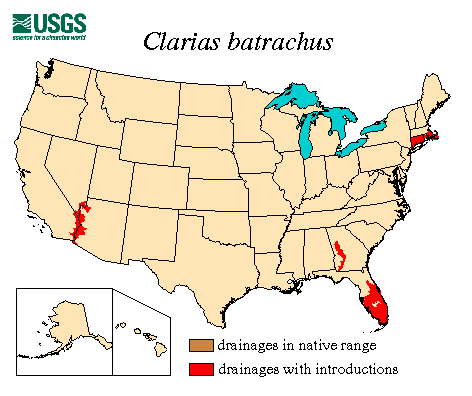Scientific Name: Clarias batrachus

Identification:
Walking catfish, which are
scale-less, are typically a uniform shade of gray or gray-brown with
many small white spots along their sides. The head is flat and
wide and the body tapers to the tail. The eyes are very small and
the mouth is broad with fleshy lips and numerous small pointed teeth in
large bands on both the upper and lower jaw. There are four pairs
of barbels, one pair each of maxillary and nasal barbels and two pairs
of mandibal barbels. The fish has a lengthy dorsal and anal fin
that each terminate in a lobe near the caudal fin. The pectoral
fins, one on each side, have rigid spine-like elements. To move
outside of water, the fish uses these "spines" and flexes its body back
and forth to "walk". The walking catfish is easy to distinguish from many of the
other North American catfish because it doesn't have an adipose fin.
In addition to the
brown or gray-brown coloring noted above, albinos and calico morphs are
also possible. However, these are uncommon in the wild. For
example, in Florida the fish that escaped were albinos but today the
albino is rare and descendants have generally reverted to the dominant,
dark coloring.
The fish reach
reproductive maturity at one year and grow up to 24 inches in their
native range. However, in Florida they rarely exceed 14
inches.
Walking catfish
possess a large accessory breathing organ which enables them to breath
atmospheric oxygen. They are well known for their ability to
"walk" on land for long distances, especially during or after
rainfall.
Original Distribution: The
walking catfish are a
widely distributed species found across Southern Asia including
Pakistan, Eastern India, Sri Lanka, Bangladesh,
Myanmar, Thailand, Malaysia, Indonesia, Singapore, Borneo, Laos and the
Philipines. It's hard to determine, though, to what extent this
distribution comprises the native range. In Southeast Asian this
fish in valued for food and it's probable that human activity is
responsible for the presence of this species in parts of its current
range.


Current
Distribution: In addition to the locations listed above, the
walking catfish has been found in the US. Specimens have been collected
in multiple locations across California, the All American Canal in
Arizona, widely separated bodies of water in Connecticut, the Flint
River in Georgia, a lake in Massachusetts and a spring in Nevada. They
are found across southern Florida. The only established, wild
population is in Florida.
Outside of Florida:
Tropical fish
dealers in the US imported the walking
catfish to be sold as pets. The walking catfish that were found
in the US outside of Florida most likely came from aquarium releases
(intentional or accidental).
Florida: In the
early 1960's, the
walking catfish was imported to Florida from Thailand for the aquarium
trade. The first introductions apparently happened in the mid
60's when adult fish, imported to be brood stock, escaped from Penagra
Aquarium in Broward County and/or from a truck transporting brood fish
between Dade and Broward counties. In 1967, the state of Florida
banned the importation and possession of walking catfish.
However, this led to another release of the fish into the wild.
Fish farmers in Tampa Bay who possessed the fish purposefully released
them so that they would not be found in violation of the new law.
In 1968, this species
was only found in three south Florida counties. However, by 1978,
the
walking catfish had spread to 20 counties in the southern half of the
peninsula. The fish accomplished this migration by using the many
hundreds of miles of interconnected canals across south Florida and by
moving over land, typically during rainy nights. By the mid
1970's,
the walking catfish was established in Everglades National Park and in
Big Cypress National Preserve.

Walking catfish are sensitive to cold temperatures (lethal temperature is 9.4 - 12.8 degrees Celsius). During cold, dry months, they burrow into the sides of streams and ponds where they remain dormant until the spring rains. Even with this precaution, though, the populations suffer periodic die-offs when the temperature dips below freezing. This sensitivity has limited their migration north into colder areas. However, concern remains that they could find refuge in the warm springs in north central Florida and survive short cold spells by burrowing in the mud.
Mode(s) of Introduction: Since the 1960's (and possibly before) walking catfish have been imported into the US to be sold as pets. Once in the US, they either escape from their environment or are purposefully let go. On the internet, there are anecdotal stories of walking catfish owners who have lost the fish because they literally walk away. Today, the US government requires a federal permit to own one of these fish but there are still pet stores advertising them for sale.
Reason(s) Why it has Become
Established:
Walking catfish are hardy fish which can thrive where many other fish
struggle to survive. In addition to lakes and rivers, they can be
found in brackish waters or warm, stagnant, often hypoxic waters such
as muddy ponds, canals, ditches, swamps and flooded prairies.
They can remain dormant through periods of drought and go several
months without eating. When they do eat, they consume a wide
variety of prey.
In addition, walking catfish have high fecundity and the males guard the eggs and free-swimming young, giving them a better chance of survival than the native, non-protected young of other species.
Ecological
Role: Walking catfish are voracious, opportunistic feeders who are
mainly active at night. They consume a wide
variety of prey including eggs and larvae of other fishes, small
fishes,
a number of invertebrates including crustaceans and insects and
sometimes plant materials. In
densely populated drying pools, these fish become even more
indiscriminate and quickly consume most other species present.
Walking
catfish of all ages and size fall victim to a wide variety of predators
including other fish, reptiles, birds and mammals. They are also
killed by cars when migrating en masse across streets from one body of
water to another.
Benefit(s): The walking catfish can survive extended periods out of water. In its native areas, this makes it an attractive food fish which easily can be sold and traded live. The species is fished by subsistence fisherman as well as managed at commercial farming operations.
Threat(s): Walking
catfish have been know to invade aquaculture farms and
eat large amounts of fish stock. Fish farmers in Florida have had
to put up fences or build levees to keep them out. An additional
threat to catfish fisheries, specifically, is the fact that wild
walking catfish carry the disease enteric septicemia (ESC) caused by
the bacterium Edwadsiella ictaluri.
Wild walking catfish could infect farmed catfish with the disease.
In Florida, the total
impact on native species is unknown. We do know, though, that
walking catfish are extremely pervasive across southern Florida and
many scientist consider the introduction of the walking catfish into
the area as one of the most harmful introduction in North
America. Walking catfish are
especially devastating in small wetland pools during the dry season
where
they can quickly become the dominant species. The species that appear
to be most affected are native centarchids and catfishes.
The walking catfish
is a tropical fish and, if introduced into other warm areas of the US,
the spread of the fish could mirror what happened in Florida.
Southern Texas and Hawaii are examples of two US areas that could be
vulnerable.
Control Level Diagnosis: I rank this threat as medium priority. In Florida, the population is established and it's northern migration is slowed by freezing temperatures. However, it is crucial to keep this fish out of other areas where it could flourish.
Control
Method: Numerous countries have "blacklisted" the walking
catfish. The United States has classified all members of the
family Clariidae as injurious wildlife, illegal to possess without a
federal permit. It is important to keep this fish contained
because, once out in the wild, the population growth could be explosive
in areas where there is a mild climate. In addition, the walking
catfish is very hardy. It can survive months without food, and
live in water that other fish would find intolerable. Poisoning
it would be very difficult because it could walk elsewhere to avoid the
poisons.